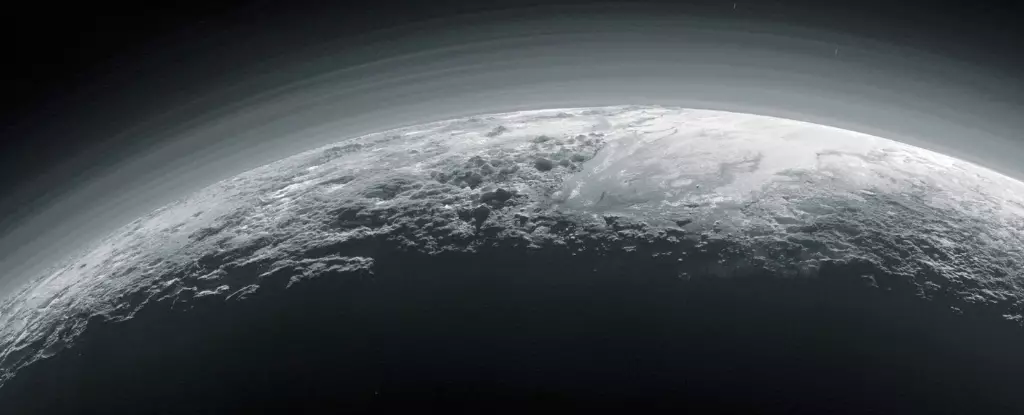The journey of the New Horizons spacecraft past Pluto and Charon in July 2015 forever changed our understanding of these distant celestial bodies. No longer are they simply frozen, lifeless orbs; instead, they emerged as complex worlds with intricate atmospheres and dynamic geological processes. The latest observations from the James Webb Space Telescope (JWST) in 2022 and 2023 have further amplified this revelation, unearthing details about Pluto’s atmosphere that challenge our grasp of planetary science. Unlike any other atmosphere in the Solar System, Pluto’s atmospheric phenomena are driven by a peculiar interplay of haze particles that respond to temperature shifts, offering us unparalleled insights into atmospheric behavior.
The Unusual Dance of Haze Particles
One of the most striking features identified in recent studies is Pluto’s active atmosphere, composed predominantly of nitrogen, methane, and carbon monoxide. The presence of haze particles, which rise and fall with temperature fluctuations, exemplifies the complex relationships within its atmosphere. This seasonal dance, which has not been documented on any other world, allows these haze particles to modulate the energy balance of Pluto’s atmosphere. As they are heated, they interact with incoming solar radiation and vice versa, resulting in a thermal equilibrium that diverges sharply from what we witness in atmospheres on planets like Mars and Saturn.
The innovative hypothesis put forward by astronomer Xi Zhang in 2017 appeared audacious at the time. He proposed that if Pluto’s haze were indeed contributing to cooling processes, strong mid-infrared emissions should be observable. The JWST turned these ideas into tangible data, confirming Zhang’s predictions in what can only be described as an exhilarating moment for astronomers. It is indeed rare for a hypothesis in planetary science to be validated so swiftly, and the consequent excitement among researchers illuminates how critical this find is for the field.
Pluto Versus Charon: Atmospheric Contrast
While Pluto dazzles with its multifaceted atmosphere, its companion Charon stands in stark contrast. Charon is almost devoid of an atmosphere, with fleeting instances of outgassing appearing seasonally. The stark differences between the two worlds deepen the intrigue surrounding their relationship. The atmospheric activity observed on Pluto may not be just a product of its environment but can be viewed as part of an intricate system shared with Charon, where interactions lead to interesting ice migrations and exchanges.
The data from the JWST indicate that Pluto’s surface exhibits variations in thermal radiation, implicating a complex interaction of the atmosphere with the surface ice. Seasonal changes cause materials to migrate from Pluto to Charon, facilitating a unique transfer of volatiles that further complicates our understanding of both moons. The very distribution of ice across Pluto’s surface suggests an active hydrological cycle of sorts, although one distinct from terrestrial experiences.
The Implications for Planetary Science
The unique aspects of Pluto’s atmosphere, particularly the reliance on haze particles for its energy balance, suggest that Earth’s early atmosphere may have shared some similarities. Zhang’s observations could yield new insights into how primordial conditions might have enabled the development of life. The study of Pluto’s haze may illuminate the chemical conditions that once prevailed on our planet, illuminating a path connecting distant worlds with our own evolutionary narrative.
Notably, Pluto’s findings extend their reach beyond its borders. Researchers are increasingly aware of the parallels that can be drawn with other celestial bodies, such as Titan and Triton, which – despite their differences in size and distance – exhibit similar atmospheric characteristics. The revelations from Pluto offer a new lens to understand and compare these worlds, expanding our collective knowledge about planetary atmospheres throughout our Solar System.
A New Frontier in Atmospheric Studies
As the JWST continues its observations, researchers hope to unlock even more secrets from Pluto’s complex atmosphere. The studies are paving the way for broader implications in planetary science and atmospheric studies. The specifics of haze particle behavior in extreme conditions can not only inform our understanding of remote solar bodies but may also apply to exoplanets beyond our Solar System, where similar atmospheric phenomenon could occur.
Pluto stands at the frontier of planetary studies, inviting us to think beyond established paradigms. The discoveries made thus far remind us that the universe is rife with surprises and complexities that challenge our conventional understanding. Each layer we peel back offers a glimpse into the dynamic forces shaping worlds that, although separated by vast distances, are intricately connected through universal laws of physics and chemistry.

